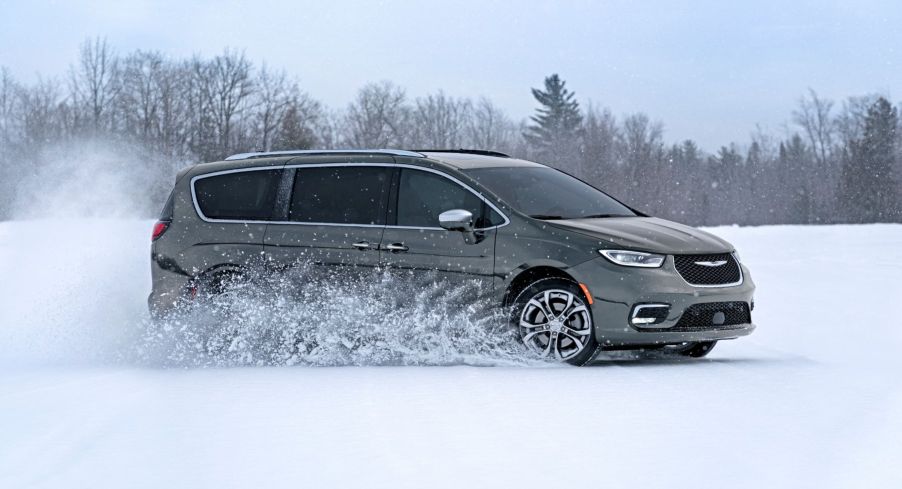
All-Wheel Drive (AWD) in a Minivan: Necessary, Pointless, or Fun?
An all-wheel drive (AWD) system is primarily marketed to drivers who want to go off-roading or drive in snowy or rainy weather. Typically you’ll see it on daily driving SUVs, while pickups tend to have four-wheel drive (4WD). A minivan, though, doesn’t usually come with it. Instead, you’ll find them with front-wheel drive.
So, should automakers offer more AWD minivans, or would it needlessly add more money to the price tag?
How does all-wheel drive work?
In a two-wheel drive (2WD) vehicle, power gets sent to two wheels. For a front-wheel drive (FWD) model, it’s to the front wheels, and the back ones get it if the car is a rear-wheel-drive (RWD) model. When it comes to the all-wheel drive system, though, power goes to all four wheels on the vehicle, much like 4WD.
With four-wheel drive, you can switch back and forth between two wheels and four. In an AWD system, you don’t have to worry about it. The drivetrain will do all the work for you when it senses you need it. There are two types of all-wheel drive systems on the market. One works part-time (on-demand), and the other full-time.
The on-demand option is where you start with 2WD (either front or rear), and if a wheel starts slipping, it will kick in all four wheels. Full-time is when all four wheels get power at all times, much like 4WD. The difference is you can’t switch it to a two-wheel configuration.
The pros and cons of having AWD on a minivan

As with just about anything, there are good and bad points to an all-wheel drive system on a minivan. First, let’s start with the pros reported by Edu Autos.
- Better acceleration – Traction is distributed to all four wheels on a minivan, helping it accelerate from a complete stop.
- Better handling – An all-wheel drive system will enable the minivan to handle more efficiently on the road, offering a safe driving experience.
- Increases value of the van – With an AWD system, the van will be worth more for trade-in or to sell privately.
Now, let’s examine the cons of having an AWD system on a minivan.
- Fewer fuel savings – In most cases, an all-wheel drive vehicle will get worse fuel economy than one without because of the AWD system’s extra weight and power needs.
- Not meant for off-roading -While minivan owners aren’t typically off-roading drivers, it’s important to note that if you plan on going off the trail, an AWD system isn’t going to help you on uneven terrain.
- More expensive – AWD is more expensive to buy on any vehicle. Additionally, it will cost more to maintain it for the duration you own the car. However, most AWD systems will run power on two wheels until it senses the vehicle needs more to limit wear and tear.
- Won’t help you stop – AWD offers better acceleration but no stopping power on slippery surfaces. You’re better off with an FWD vehicle sporting decent winter tires to provide traction on the road.
Basically, having AWD on a minivan really isn’t worth it. It only becomes beneficial when you drive in areas with a lot of snow and icy weather. However, stopping efficiently with it is pretty difficult when the road is slippery.
Is it worth the extra money, though? We don’t think so, but if you like how the van drives with it, then go for it; just don’t expect it to be invulnerable.
Which minivans have all-wheel drive?
While a handful of minivans are still on the market, only two come with an AWD system. According to Edmunds, the Toyota Sienna has all-wheel drive standard on some of its upper trim levels. It also offers a hybrid powertrain consisting of a 2.5-liter Inline-four and an electric motor setup, giving drivers a 36 combined mpg rating.
With the Chrysler Pacifica, you can choose AWD on some trim levels. This model offers a 3.6-liter 6-cylinder engine paired with a nine-speed shiftable automatic transmission. Fuel economy ratings aren’t too bad for a minivan, delivering 20 mpg overall. The Pacifica’s hybrid models have better mileage but don’t offer AWD.
Honda has its Odyssey minivan model, which offers a 3.5-liter 6-cylinder that provides 22 mpg overall. There is no hybrid for it, though. Additionally, this model only comes with front-wheel drive.
The last minivan available is the Kia Carnival, formerly known as the Sedona. With this minivan, you get a 3.5-liter V6 engine with a 22 mpg combined rating. No hybrid powertrain is available like the Odyssey, but there’s talk of one coming soon.
Having AWD is great if you plan to do some off-roading or drive in snowy conditions. However, minivans aren’t equipped to drive off the trail, and having winter tires on a front-wheel-drive vehicle is better than spending extra money on AWD.


